

Copyright 2006 EA Tischler - New Horizons Golf Approach. All rights reserved.
| New Horizons Golf Approach I n n o v a t i v e C o a c h i n g F o r G o l f e r s |
Ball Striking Skills
This article is from New Horizons Pocket Coach volume 4- Ball Striking Skills written and copyrighted by EA Tischler. Prelude: This volume of the New Horizons Golf Approach Pocket Coach Series is dedicated to the feeling most golfers dream about. Beginners feel it once in a great while. Avid golfers feel it periodically, and the accomplished golfer flows in and out of it with regularity. However, few know how to reproduce it on demand. Even professional golfers dream about the secret to its execution. Ben Hogan had it, and everyone that watched him knew he had it. The mystique he left the golfing world was founded in his mastery of it. Hogan set the standard and golfers have been searching for the secret ever since. Since Hogan set the standard, only a few have owned the ability to reproduce the feel. Players like Lee Trevino and Moe Norman are a couple of those players. Thru observation and experience a couple of things have become quite clear. If you don’t first establish the game’s true fundamentals, you will never find it. Additionally, if you don’t nurture consistent focus, you’ll never sustain it. So, what is It? Why was Mr. Hogan so revered by all who watched him? And why were his peers in awe of what he possessed? The answer is, “The Secrets of Pure Ball Striking.” It seems to me that if all golfers were granted one wish, most of them would choose to be a good ball striker over being a good scorer. There’s something captivating about the sound and feel of good ball striking. And the experience is often more luring than shooting your career low score. I know most of my students recall their best ball striking rounds more than their low scoring rounds. The low scoring rounds are usually qualified with, “Yeah, but I made every putt I looked at.” Whereas, they don’ t seem to care as much about how they putt on good ball striking days. PGA Tour Professionals are more concerned with their style of play than amateurs, and their style tends to fall into one of three categories. Players are known to be fundamentally sound, great ball strikers, or great shot makers. Then there are the few exceptional players that seem to possess the skills of all three categories. Fundamentally Sound golfers tend to be very consistent, are mechanically efficient, and play the percentages. Byron Nelson, Jack Nicklaus, Hale Irwin, Tom Kite, Scott Simpson, Mark O’Meara, Loren Roberts, Jeff Sluman, and Ernie Els all fit this category. These players tend to play the majors quite well. Even though they are not necessarily known as either great ball strikers, or great shot makers, they all have a tremendous command over their fundamentals and their ability to focus under pressure. These players all seem to make the most out of their talents, while other more naturally gifted players may not. Great ball strikers also display a sense of consistency. However, they do so while compressing the ball more purely. Though most good ball strikers play their shots very accurately, not all good ball strikers express such a high level of precision. It is generally the great ball strikers who display higher levels of precision. Good ball strikers are always on the verge of becoming great, yet falter more often under pressure. For example, Ben Hogan was known as one of the greatest ball strikers of all time, while Vijay Singh is known as a very good ball striker. Though Vijay Singh is one of the hardest working pro’s on the PGA Tour, his precision could be better. Of course I am comparing him to Ben Hogan, so don’t think for a minute that Vijay Singh’s skills are subpar. Indeed he continues to improve and will soon contend for the #1 player in the world status. Other great ball strikers include Gary Player, Lee Trevino, Tom Watson, Johnny Miller, Nick Price, Bill Glasson, Steve Elkington, Scott McCarron, David Toms, and David Duval. All these players display good command over the fundamentals as well as the skills of compressing the ball with consistency and precision. This makes them all contenders in major championships. Great shotmakers tend to depend a lot on their imagination and natural abilities, including a tremendous amount of talent with their eye-hand coordination. Although these players may also have some ball striking prowess, they are more well known for their ability to maneuver the ball. They also tend to play with enthusiasm and a go-for-broke attitude. Their ability to play magical shots from trouble seems to be endless. We love to watch these players because they make the game exciting. Players like Sam Snead, Arnold Palmer, Seve Ballesteros, Chi Chi Rodriquez, Corey Pavin, Phil Mickelson, and Sergio Garcia all bring this type of excitement to the game. In many ways they lure the fans into this type of play, and therefore become fan favorites. These players all enjoy the challenge of playing the ideal shot for the present situation. They enjoy working the ball into the course design, or out of trouble situations. “Lay-Up” is rarely a shot selection for these players. As mentioned earlier, there are players who seem to have a command of all three categories. Ben Hogan was certainly known as a great ball striker, but I believe he possessed the full range of skills. I also believe, Bobby Jones, Mickey Wright, George Knudson, Tom Watson, Greg Norman, Nick Faldo, and Tiger Woods have shown their prowess of all three categories. As a side note, the great triumvirates of each era seem to have one shotmaker, one ball striker, and one fundamental player. Hagen-Jones- Sarazen, Snead-Hogan-Nelson, Palmer-Player-Nicklaus, and Ballesteros- Watson-Nicklaus all come to mind. Interestingly enough, during those periods that there was not a triumvirate, somebody seemed to reign who possessed all the skills. Greg Norman did so for the longest stretch as number one in the world. Nick Faldo seemed to be the Major Championship Man. Now Tiger Woods seems is dominating the scene. Keep an eye out in the future. We may witness Phil Mickelson, Tiger Woods, and Ernie Els as the next triumvirate. Or, maybe Vijay Singh will round out the pack. With this overview in mind, if you dream of the sound of percussion, if you savor the sweetness of pure ball striking, then this Pocket Coach is for you. One last note before we get started, I am going to describe all the physical actions in terms of being a right- sided golfer. I apologize to the left-handed golfer, but the condensed length of this Pocket Coach book makes it too difficult to describe all actions from both sides of the ball. I will, however, use the terms dominant and non- dominant as much as possible without disrupting the flow of instruction. |
This page expresses the New Horizons Golf philosophy behind becoming a great ball striker. |
| This article is from New Horizons Pocket Coach volume 4- Ball Striking Skills written and copyrighted by EA Tischler. The Line Of Compression When we think of great ball strikers, we recall the special sound that comes from compressing the ball just so. I call this sound “percussion,” and the better the ball striker, the deeper the percussion. So the secret to great ball striking is learning how to compress the ball properly. For this reason, I think we should call ball strikers, “ball compressors.” I also believe the terms “hitting” and “striking” can be quite misleading. The image of hitting the ball often leads the average golfer away from their truest swing. The intent to strike the ball could be just as misleading. I prefer saying I am going to compress the ball, or even better yet, to “play the ball.” Playing the ball implies that there is a location for the ball to be played toward – the target. “Compressing the ball,” dictates that something must happen beyond contacting the ball. It dictates that the ball must rebound from the compression stroke, and that it must be directed all the way through the moment of separation. Separation being the moment the clubface transfers its flight instructions to the ball. However, since the term “ball striking” has been used for so many years, we will continue to use it for now. Though we will continue to use the phrase, try to imagine ball striking as the process of compressing the ball down your intended line of flight. For this reason, I will also use ball compressing when I feel it appropriate to emphasize the image. Therefore, the secret to great ball striking is sustaining the line you compress the ball along. The longer the line of compression, the better the ball striking experience, and the straighter the ball will fly. So, understanding how to compress the ball down as long and straight a line as possible is the answer to consistently experiencing the type of ball striking you desire. And the rest of this Pocket Coach Volume will focus on unveiling and experiencing the skills needed to sustain this line of compression. Establishing The Line As we’ve already discussed, sustaining the line of compression is the secret to great ball striking. Establishing the line by learning to swing the club down the line is half the battle. The more you swing the club on a path that traces the intended line of compression, the easier it will be to compress the ball properly. More specifically, the closer the club stays to this path during the backswing and transition, the easier it will be to trace the line during the forward swing. Also, the further the club swings away from this path during the backswing and transition, the harder it is to swing the club down the line during the forward swing. Therefore, strive to swing the club on a path that delivers it as down the line as possible. If you recall reading Volumes One and Two of this Pocket Coach series, you may remember the first fundamental of the New Horizons Golf Approach is the act of following through to your target. This is because, the only way your swing can insure a consistent delivery of the ball to the target is by following through down the line toward the target. It should be obvious that the path you swing the club back-n-thru on will have a major influence on how precisely you follow-thru to your target. It should also be obvious that the more your swing travels back-n-thru on the same path, the easier it will be to play your shots directly toward your intended targets. So, we want to develop the skill of swinging the club back-n-thru on one path, or as close to one path as possible. Therefore, as you learn to establish the line of compression, you are actually fine-tuning the act of following- thru to your target. For the purpose of this book we will call this process “tracing-the-line.” While executing the tracing-the-line drill you will certainly become more familiar with the feeling of establishing the line. Whether you call the feeling tracing the line or something else does not matter, as long as it accomplishes the task of delivering the club down the intended line to your target. As you trace the line, look for and pay attention to what tracing-the-line feels like to you. When you trace the line properly, you will know what it feels like for you, then you can give it a name. Be descriptive with the name. Give it a name you will remember. Remembering the feeling is key to reproducing the action. Tracing-The-Line Drill To acquire the feeling of tracing the line, we will use the trace-the-line drill. Begin by laying two clubs on the ground along your target line. Lay the first one on the down the line portion of your target line, and place the second one on the backswing portion of the target line. Try to align the shafts exactly along the target line, and leave a 5 to 6 foot gap between the two of them. Place a ball in the middle of the gap between the clubs (see diagram), then play a shot. As you play each shot, pay attention to the direction of your follow-thru. Notice whether your club points at the down the line shaft, to the left of the down the line shaft, or to the right of the down the line shaft during the initial stages of the follow-thru. If your club points at the down the line shaft during the follow-thru, then you are tracing the line. Whether you trace the line or not, notice that the ball starts to fly in whatever direction you follow-thru. As you continue playing shots, notice that the more you trace the line during the backswing, the easier it is to trace the line in the forward swing. Although it is not a fundamental necessity to trace the line during the backswing, learning to trace the line during the backswing allows you to more consistently trace the line during the follow-thru. Since it is fundamentally necessary to trace the line during the forward swing, focus most of your attention on achieving this goal. If you find that a slightly outside, or inside, the line backswing path makes it easier to perfectly trace the line in the forward swing, then feel free to do so. Remember, many professionals swing outside the line during the backswing, and many professionals swing inside the line on the backswing. However, all professionals do their best to trace the line as perfectly as possible during the forward swing. Execute tracing the line with half swings first. Place a ball between the two clubs, and assume your address position. In slow motion, start your takeaway while being attentive of the condition of keeping the club shaft pointing toward the intended line. If the clubshaft continues to point at the intended line, you are tracing the line during the backswing. Once the club is waist-high, transition forward while being attentive of retracing the line during the forward swing. As you continue the forward swing, trace-the-line through the impact position, then down the line in the follow- thru. Repeat this process two or three times in slow motion, then play some waist-high to waist-high shots. You can also train this tracing the line feeling at home. You don’t need to play any shots. Simply make a line on the ground and rehearse tracing-the-line. Remember, although we ideally want to trace the line throughout the whole swing, it is only necessary to trace- the-line from waist-high to waist-high. Many great ball strikers have slight reroutes in their swings; however, all great ball strikers trace-the-line between waist-high to waist-high. Tracing the line above waist-high is concerned with tracing the swing plane. This being the case, we’ll discuss the patterns for swinging on plane in another Pocket Coach volume entitled “The Plane Truth.” Review the following pictures of the Tracing-The-Line drill. |
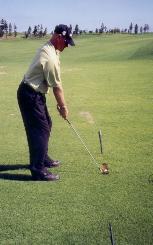
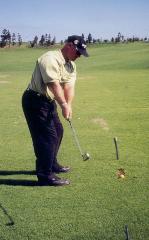
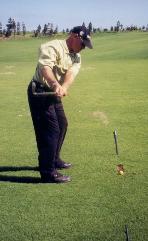
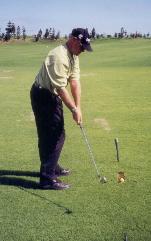
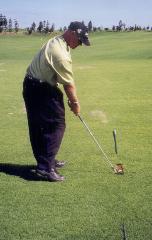
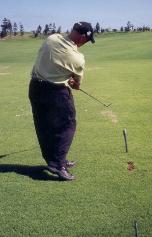
(Above) During the forward swing, notice how the clubshaft continues to point at the intended line. As long as it is pointing at the intended line, your swing is tracing the line. Rehearse tracing the line back and forth until you confidently recognize the feel. In the picture to the far right the club is parallel to the ground and pointing at the target. Once again, rehearse this process until you are confident in the feeling of executing a tracing the line swing. Begin your training in slow motion. As your confidence improves, you can work your tempo up to a normal pace. When you are confident swinging at a normal pace, you can play shots with the motion. If executed well, your waist-high to waist-high swings will be playing the ball straight down the intended line toward your target. Eventually you will become so aware of this feeling that it will works its way into your full swing. Be discipline with your tracing the line training. Ben Hogan trained a similar drill every day, and he was one of the best ball strikers the game has ever seen. |
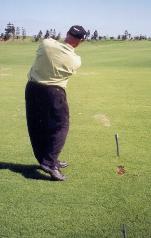

(Above) Notice how the club points at the line during the backswing. It continues to point at the line, or down the line, until the club is parallel to the ground. When the club is parallel to the ground the shaft is parallell to the target line. (Far right above) As my club travels slightly past waist-high the grip end of the club points down the line toward the target. As long as one end of the club points at the target line the swing remains on-plane. Doing so when the club is swinging from waist-high to waist-high satisfies tracing the line. |

The swing sequence above captures some wonderful moments where the club is being swung in a tracing the line manner. The first 3 frames (from left to right in the top part of the sequence) show the takeaway tracing the line in the backswing. In the 4th frame the clubshaft is pointing at the target-line and almost pointing at the ball. As the swing returns forward the club points back at the ball (2nd frame from the left in the bottom part of the sequence), Both the clubshaft and my left arm are clearly on-plane at this point. From impact to the full extension the club continues to trace the line and swing up the plane (3rd and 4th frames from the left in the bottom sequence). Learning to swing the club dynamically in this manner will help you become a great ball striker. |